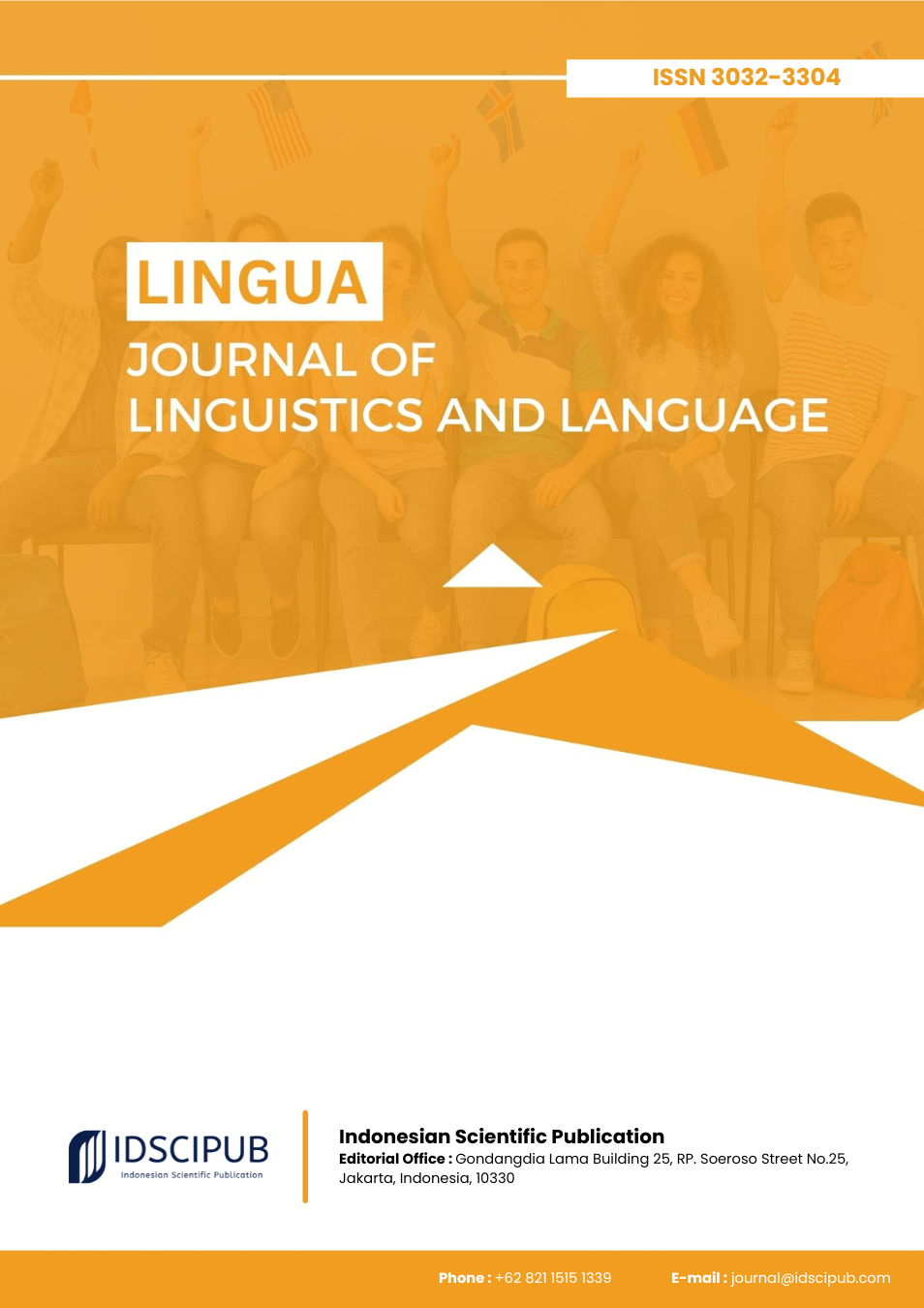Revisiting the Syntax–Semantics Interface: Theoretical, Empirical, and Computational Insights
DOI:
https://doi.org/10.61978/lingua.v3i2.1045Keywords:
Syntax–Semantics Interface, Generative Grammar, Distributional Semantics, Bilingualism, Cross-Linguistic Variation, Computational Linguistics, Language AcquisitionAbstract
The syntax–semantics interface has become a central focus in linguistics, as it explains how structural configurations shape meaning and how interpretation constrains syntactic possibilities. This review aims to synthesize theoretical, empirical, computational, and cross-linguistic perspectives to provide a comprehensive account of the interface. Findings indicate that generative and minimalist theories emphasize structural roles, while constructionist and distributional models highlight usage and context. Empirical studies reveal challenges for bilingual and heritage speakers, and computational approaches demonstrate the value of hybrid models bridging theory and data. The review contributes to advancing linguistic theory and practice by underscoring the need for integrative models that combine formal rigor, empirical validation, and cross-linguistic inclusivity.
References
Al-Thubaiti, K. (2018). Selective vulnerability in very advanced l2 grammars: evidence from vpe constraints. Second Language Research, 35(2), 225-252. https://doi.org/10.1177/0267658317751577 DOI: https://doi.org/10.1177/0267658317751577
Asudeh, A. (2022). Glue semantics. Annual Review of Linguistics, 8(1), 321-341. https://doi.org/10.1146/annurev-linguistics-032521-053835 DOI: https://doi.org/10.1146/annurev-linguistics-032521-053835
Bjorkman, B. (2022). Some structural disanalogies between pronouns and tenses. The Canadian Journal of Linguistics / La Revue Canadienne De Linguistique, 67(3), 143-165. https://doi.org/10.1017/cnj.2022.26 DOI: https://doi.org/10.1017/cnj.2022.26
Boleda, G. (2020). Distributional semantics and linguistic theory. Annual Review of Linguistics, 6(1), 213-234. https://doi.org/10.1146/annurev-linguistics-011619-030303 DOI: https://doi.org/10.1146/annurev-linguistics-011619-030303
Borgonovo, C., Garavito, J., & Prévost, P. (2014). Mood selection in relative clauses. Studies in Second Language Acquisition, 37(1), 33-69. https://doi.org/10.1017/s0272263114000321 DOI: https://doi.org/10.1017/S0272263114000321
Bouveret, M. (2021). Lexicalization, grammaticalization and constructionalization of the verb give across languages., 1-22. https://doi.org/10.1075/cal.29.int DOI: https://doi.org/10.1075/cal.29.int
Devine, A., & Stephens, L. (2017). Towards a syntax-semantics interface for latin. Catalan Journal of Linguistics, 16, 79. https://doi.org/10.5565/rev/catjl.210 DOI: https://doi.org/10.5565/rev/catjl.210
Dudschig, C., Kaup, B., Liu, M., & Schwab, J. (2021). The processing of negation and polarity: an overview. Journal of Psycholinguistic Research, 50(6), 1199-1213. https://doi.org/10.1007/s10936-021-09817-9 DOI: https://doi.org/10.1007/s10936-021-09817-9
Ellis, N., O’Donnell, M., & Römer, U. (2014). Second language verb-argument constructions are sensitive to form, function, frequency, contingency, and prototypicality. Linguistic Approaches to Bilingualism, 4(4), 405-431. https://doi.org/10.1075/lab.4.4.01ell DOI: https://doi.org/10.1075/lab.4.4.01ell
Giannakidou, A., & Etxeberria, U. (2018). Assessing the role of experimental evidence for interface judgment: licensing of negative polarity items, scalar readings, and focus. Frontiers in Psychology, 9. https://doi.org/10.3389/fpsyg.2018.00059 DOI: https://doi.org/10.3389/fpsyg.2018.00059
Gonering, B., & Corina, D. (2023). The neurofunctional network of syntactic processing: cognitive systematicity and representational specializations of objects, actions, and events. Frontiers in Language Sciences, 2. https://doi.org/10.3389/flang.2023.1176233 DOI: https://doi.org/10.3389/flang.2023.1176233
Gotham, M. (2018). Making logical form type-logical: glue semantics for minimalist syntax. Linguistics and Philosophy, 41(5), 511-556. https://doi.org/10.1007/s10988-018-9229-z DOI: https://doi.org/10.1007/s10988-018-9229-z
Herbay, A., Gonnerman, L., & Baum, S. (2018). How do french–english bilinguals pull verb particle constructions off? factors influencing second language processing of unfamiliar structures at the syntax-semantics interface. Frontiers in Psychology, 9. https://doi.org/10.3389/fpsyg.2018.01885 DOI: https://doi.org/10.3389/fpsyg.2018.01885
Jin, J., Ke, S., & Lee, J. (2022). Language interfaces in adult heritage language acquisition: a study on encoding of nominal reference in mandarin chinese as a heritage language. Frontiers in Psychology, 12. https://doi.org/10.3389/fpsyg.2021.790102 DOI: https://doi.org/10.3389/fpsyg.2021.790102
Kubota, Y., & Levine, R. (2015). The syntax-semantics interface of ‘respective’ predication: a unified analysis in hybrid type-logical categorial grammar. Natural Language & Linguistic Theory, 34(3), 911-973. https://doi.org/10.1007/s11049-015-9315-7 DOI: https://doi.org/10.1007/s11049-015-9315-7
Lebkuecher, A., & Malt, B. (2021). Second-language influence on first-language animacy constraints and word order in korean–english bilinguals. The American Journal of Psychology, 134(4), 385-403. https://doi.org/10.5406/amerjpsyc.134.4.0385 DOI: https://doi.org/10.5406/amerjpsyc.134.4.0385
Li, Y., Zeng, T., & Liu, Z. (2025). Testing the interface hypothesis: evidence from processing directions of possession transfer in double object constructions by l1-mandarin chinese l2-english learners. Plos One, 20(2), e0313965. https://doi.org/10.1371/journal.pone.0313965 DOI: https://doi.org/10.1371/journal.pone.0313965
Malaia, E., & Newman, S. (2015). Neural bases of syntax–semantics interface processing. Cognitive Neurodynamics, 9(3), 317-329. https://doi.org/10.1007/s11571-015-9328-2 DOI: https://doi.org/10.1007/s11571-015-9328-2
Morrill, G. (2014). A categorial type logic., 331-352. https://doi.org/10.1007/978-3-642-54789-8_18 DOI: https://doi.org/10.1007/978-3-642-54789-8_18
Oberortner, E., & Densmore, D. (2014). Web-based software tool for constraint-based design specification of synthetic biological systems. ACS Synthetic Biology, 4(6), 757-760. https://doi.org/10.1021/sb500352b DOI: https://doi.org/10.1021/sb500352b
Poletiek, F., Monaghan, P., Velde, M., & Bocanegra, B. (2021). The semantics-syntax interface: learning grammatical categories and hierarchical syntactic structure through semantics. Journal of Experimental Psychology: Learning, Memory, and Cognition, 47(7), 1141-1155. https://doi.org/10.1037/xlm0001044 DOI: https://doi.org/10.1037/xlm0001044
Putnam, M., & Søfteland, Å. (2021). Mismatches at the syntax-semantics interface: the case of non-finite complementation in american norwegian. Nordic Journal of Linguistics, 45(3), 310-347. https://doi.org/10.1017/s033258652100010x DOI: https://doi.org/10.1017/S033258652100010X
Putnam, M., & Søfteland, Å. (2022). When covert modality sneaks into your grammar: wh-infinitives in american norwegian. Second Language Research, 40(1), 171-194. https://doi.org/10.1177/02676583221103741 DOI: https://doi.org/10.1177/02676583221103741
Sheinfux, L., Melnik, N., & Wintner, S. (2016). Representing argument structure. Journal of Linguistics, 53(4), 701-750. https://doi.org/10.1017/s0022226716000189 DOI: https://doi.org/10.1017/S0022226716000189
Stengel-Eskin, E., Murray, K., Zhang, S., White, A., & Durme, B. (2021). Joint universal syntactic and semantic parsing. Transactions of the Association for Computational Linguistics, 9, 756-773. https://doi.org/10.1162/tacl_a_00396 DOI: https://doi.org/10.1162/tacl_a_00396
Sundaresan, S. (2018). Perspective is syntactic: evidence from anaphora. Glossa: A Journal of General Linguistics, 3(1). https://doi.org/10.5334/gjgl.81 DOI: https://doi.org/10.5334/gjgl.81
Szabolcsi, A. (2024). Cross-linguistic insights in the theory of semantics and its interface with syntax. Theoretical Linguistics, 50(1-2), 125-133. https://doi.org/10.1515/tl-2024-2009 DOI: https://doi.org/10.1515/tl-2024-2009
Wechsler, S. (2020). The role of the lexicon in the syntax–semantics interface. Annual Review of Linguistics, 6(1), 67-87. https://doi.org/10.1146/annurev-linguistics-011619-030349 DOI: https://doi.org/10.1146/annurev-linguistics-011619-030349
Woods, R. (2015). The acquisition of dative alternation by german-english bilingual and english monolingual children. Linguistic Approaches to Bilingualism, 5(2), 252-284. https://doi.org/10.1075/lab.5.2.04woo DOI: https://doi.org/10.1075/lab.5.2.04woo
Wu, M., Zhang, L., Wu, D., & Wang, T. (2019). Effects of the interface categories on the acquisition patterns of english reflexives among learners of english as a foreign language. International Journal of Bilingualism, 24(4), 651-671. https://doi.org/10.1177/1367006919875513 DOI: https://doi.org/10.1177/1367006919875513
Zeng, L., & Hua, D. (2019). Syntax/semantics interface and interpretation of chinese np1np2v construction by japanese speakers., 341-362. https://doi.org/10.1075/lfab.15.12zen DOI: https://doi.org/10.1075/lfab.15.12zen






